Mahjong Tiles Meaning
Date:
Updated:
Table of Contents

Mahjong tiles meaning are a fascinating area to explore for anyone playing this dynamic and enjoyable game. With its origins in Qing Dynasty China, it is no surprise that Mahjong is rich in that country's symbolism. However, opening a set can be daunting initially, with the 144 different tiles, racks, and dice to contend with. The good news is that practice soon makes perfect for mastering Mahjong. An essential area of focus when learning to play the game should be identifying and understanding the various tiles, which are the foundation of the gameplay. A great way to do this is to delve deep into their meaning and symbolism. Let's explore the significance and depiction of the Suit, Honor, and Bonus tiles and build a solid understanding of their use in Mahjong.
Suited tiles
There are three suits in Mahjong, each with tiles numbered 1-9. There are four of each tile in a set, so the total for each suit is 36 tiles. They are an integral part of the gameplay of Mahjong and are akin to the pawns in chess.
Circles:

Circles or 'wheels' (pin-zu) are distinctive and easy to follow because of the circular designs on each tile. The frequency of circles directly relates to the number of the tile making them easy to interpret. This design is why they are referred to as 'Dots' since counting the dots and determining the number of the tile is straightforward. The circular shape has cultural significance in China and is associated with unity and wholeness. It may also symbolically reference the iconic tóng coin shape with its empty square center. The standard reference to wheels as a name also evokes the mystical concept of the wheel of life. As a tile, they reflect something both universal and, at the same time, earthy and grounded in everyday life.
Bamboos:
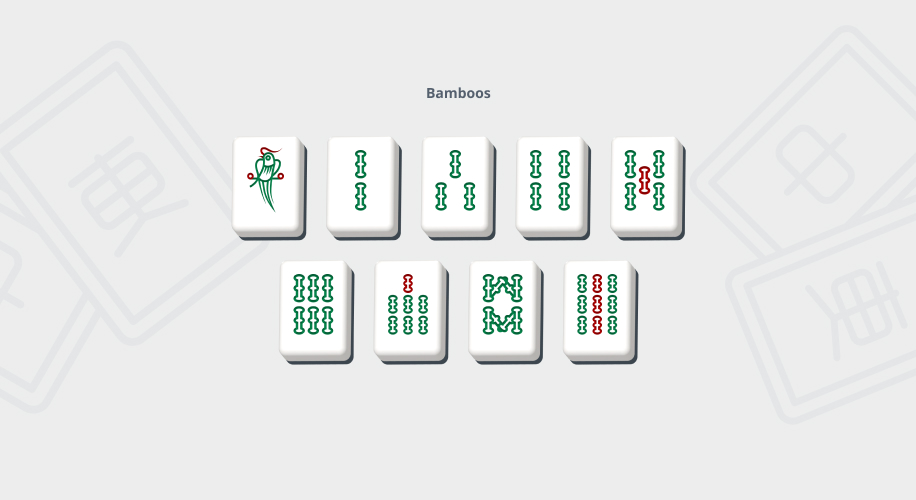
Bamboos (sou-zu), as the name suggests, depict sticks of the plant in various designs that reflect the card's number. Bamboo has profound significance in Chinese culture as a reflection of the ideals of grace, simplicity, strength, and flexibility. In this way, the tiles act as a reminder of these values when being used in the game. The first card of the suit is often a surprise for new players since instead of a solitary bamboo stick, as one would expect, it is a bird sitting on top of one. The bird is frequently depicted as a peacock, symbolically associated with beauty and dignity. When considering mahjong tiles meaning, these tiles may also be abbreviated as 'bams' or called 'sticks.'
Characters:
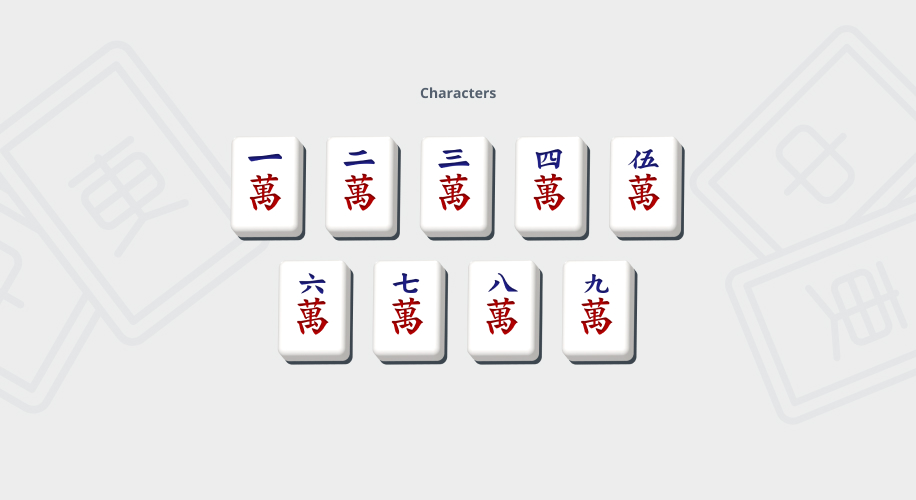
Character or 'Crack' tiles depict the Chinese language characters for the numbers 1-9 (man-zu). Depending on the Mahjong set you are using, the tiles may or may not also have a Western numeral. It is still valuable and educational to memorize and learn the characters. The lower character consistent on each tile in the suit is wàn ('10000'). The symbolism of this character is both in its relation to numbers and the idea of vastness and greatness.
Honor Tiles
Honor tiles do not have any rank or hierarchy in the game but add a powerful extra dimension to the gameplay since they can be melded with any suit. They act somewhat like the bishop or knight pieces in chess.
Winds:

Wind tiles depict the four cardinal directions found on a compass: North (běi), East (dōng), West (xī) and South (nán). There are four of each in a set, so 16 tiles in total. They may have their western first letter on the tile corner, so form the easy-to-remember sequence 'NEWS' when recalling the Mahjong tiles meaning. These tiles can also used before the game starts to determine the seating order of players. The tiles are placed face down, and each player takes one to determine who sits where, following the order' North, West, South, East). East, as the prevailing Wind is the dealer, plays first as the game commences.
Dragons:
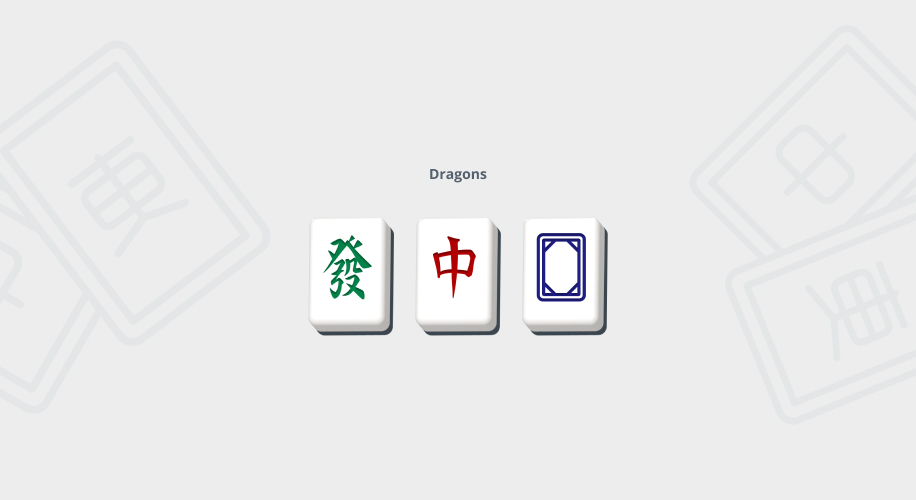
The dragon is symbolic in Chinese culture as an emblem of strength, power, and good fortune. Like Winds, they provide unique scoring opportunities. Dragon tiles have three variations - Red, Green, and White. Red and Green typically depict the mythical creature, while the White Dragon tiles can be blank or have a blue border to create the effects of a white block. Three different types appear four times each, making 12 tiles in total.
- Red Dragon (chun): This version of the mythical creature represents yang or masculine energy. Powerful, fiery, and with the energy and impulse for action. Unsurprisingly, Chinese New Year celebrations often feature red dragons.
- Green Dragon (fa): Unlike the Red, this dragon symbolizes yin or feminine energy and is more associated with the natural world. It evokes a sense of growth and renewal.
- White Dragon (pai pan): This tile embodies peace, purity, and a higher spiritual order. As its design sometimes incorporates blue in its depiction or border, it may be referred to in places as the Blue Dragon. Usually, it will be a blank tile with a border to create a white rectangular bar in the middle. It is for this reason that the White Dragon is often referred to as 'Soap.'
Dragon tiles may also be referred to as 'arrows,' using the same color format as above. In this instance, the symbolism blends Confucian virtues with the historical inclusion of archery in the Imperial Chinese examinations. For example, the red reflects an arrow hit, the Green is its aim, and the white represents a miss.
Bonus Tiles in Mahjong
Bonus tiles are not Jokers in the conventional sense (actual Joker tiles are found in American Mahjong), but their uniqueness gives them a 'wild card' feel. There are 4 of each type, and none are identical. In traditional Chinese Mahjong, these tiles cannot be used to complete melds; instead, they provide bonus points. Conversely, in the American game variation, they can be used like other Suit and Honor tiles.
Flowers:
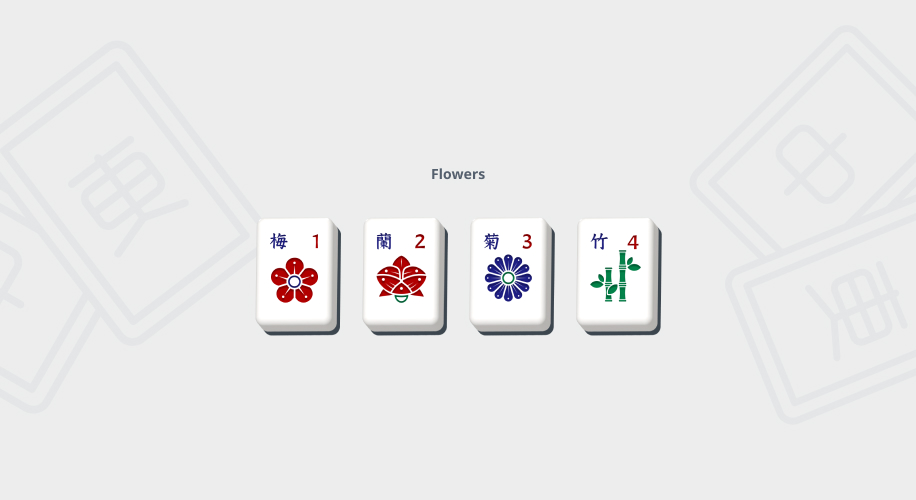
Flowers tiles (Sì Jūnzǐ) have a distinctive floral design, each depicting one of four plants with significant cultural significance in China. The plants frequently feature in Chinese art and are associated with the virtues that 6th-5th century philosopher Confucious called the 'Four Gentlemen.' Flower tiles often have their western name or an abbreviation on the tile to help with identification. In some sets, they may alternatively be numbered 1-4 in the order below.
- Plum Blossom (méi): The tile symbolizes perseverance since this plant survives and flowers during the harsh winter months. It encourages the resilience and patience required when playing Mahjong.
- Orchid (lánhuā): This plant is associated with elegance and subtlety. It reminds players of the importance of respect and dignity.
- Bamboo (zhú): The plant is known for its uprightness and strength, so the depiction evokes these virtues. In reaction to Mahjong tiles meaning, perhaps it also reminds Mahjong players of the need to stay flexible in their strategic approach. Interestingly, while bamboo is strong, it is also hollow inside, suggesting the virtue of humility.
- Chrysanthemum (júhuā): A traditional symbol of peace and tranquility, the plant on this tile reminds the player to relax and enjoy what is ultimately a game for enjoyment. It promotes the harmonious, social element of the four-player game.
Seasons:
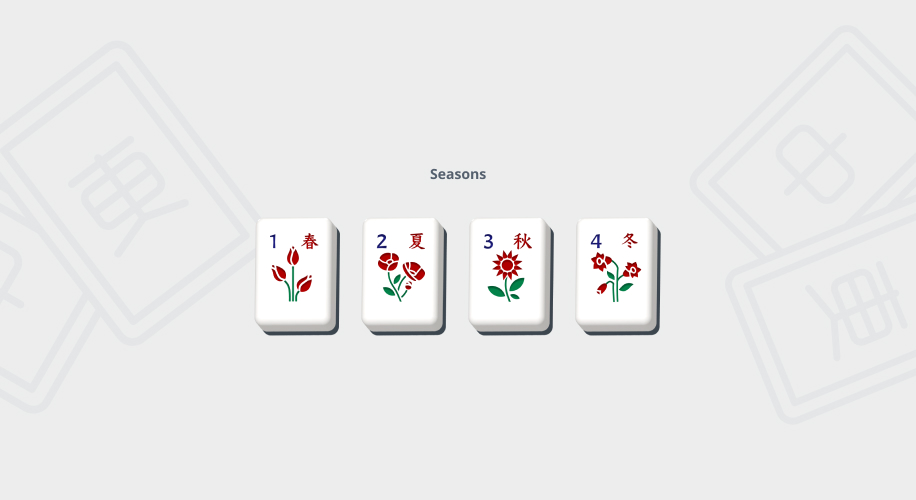
There are four tiles representing the seasons of the year:
- Spring (chūntiān)
- Summer (xiàtiān)
- Autumn (qiūtiān)
- Winter (dōngtiān)
The tiles may include their western name (or shortened version) or numbers 1-4, depending on the set used. The image used to depict the seasons can vary. Still, typically, it will involve a scene from the natural world, for example, green shoots in Spring and falling leaves in Autumn.
Animals:
Animals are not a typical bonus tile but are used as an addition in the Singapore Mahjong variation. The animals depicted can vary but typically include the following four. Notably, they tend to naturally include predator-prey pairings, for example, the cat that preys on the rat.
- Cat (māo)
- Rat (láoshǔ)
- Cockerel (gōngjī)
- Centipede (wúgōng)
There are Mahjong sets that also include rarer and more unusual bonus tiles. These may be different animals or even tiles depicting people or professions.
What Mahjong Tiles Are Made Of
Traditionally, Mahjong tiles were made from bone and bamboo, with their design either carved into the surface or drawn on with ink. This construction made for a much heavier tile than modern game versions. Antique and vintage sets that feature such materials can often be found on the market. By comparison, sets today generally use plastic tiles, with their quality broadly correlating with the price paid. Luxury Mahjong sets can have both a decorative and gaming function and will often use precious stones such as jade as the basis for the tiles. Ivory sets are now generally deemed unethical and, depending on age, may even be illegal to buy or import depending on your location.
Learning the Language of Mahjong
Mahjong tiles' meanings are like the language of the game, and there is undoubtedly a complex vocabulary to learn. Taking the time to understand the significance and symbolism of each tile category intimately is one of the best investments a player of any level of experience can make. Whether it is the mystical mythology of the Dragons or the unique qualities of the Circle, Bamboo, and Character suit tiles, Chinese cultural heritage and tradition run through the game's visual representations. As well as identifying tiles and their roles in the game, exploring Mahjong tiles meaning provides a deeper connection with the game and its history. It also allows the messages and wisdom contained in the tiles' symbolism to speak to players and inspire them in their Mahjong journey.
